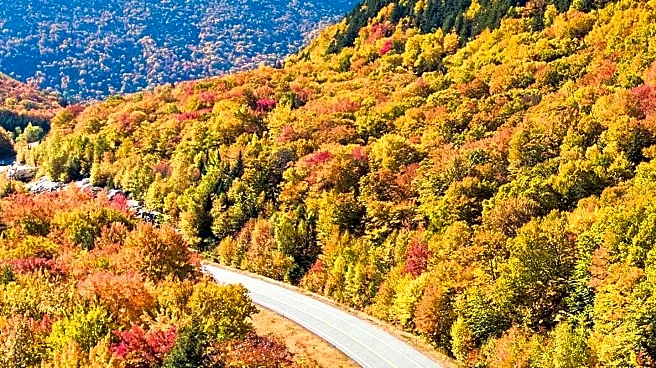What's Happening?
As October begins, fall foliage is reaching its peak across various regions in the United States. The annual transformation occurs as trees store chlorophyll, causing leaves to change from green to vibrant shades of yellow, orange, red, brown, and sometimes purple. This natural phenomenon attracts 'leaf-peepers,' or nature enthusiasts, who travel to witness the colorful displays. To aid these enthusiasts, interactive maps, such as the one provided by Smokymountains.com, categorize U.S. regions into stages of foliage development: near peak, peak, and past peak. Currently, areas with minimal foliage include parts of Missouri, South Carolina, and California, among others. Meanwhile, regions like northeastern Maine and northern Vermont have already experienced peak colors. Areas nearing peak include northeastern Washington and central Oregon, while peak colors are prominent in parts of Idaho, Montana, and the Midwest.
Why It's Important?
The fall foliage season is significant for both tourism and local economies, as it draws visitors to various regions, boosting hospitality and related industries. The vibrant colors of autumn not only provide aesthetic pleasure but also support economic activity in rural and scenic areas. For local businesses, the influx of tourists can lead to increased sales in accommodations, dining, and retail. Additionally, the use of interactive maps enhances the experience for travelers, allowing them to plan visits to areas with optimal foliage displays. This seasonal event underscores the importance of natural attractions in promoting regional tourism and economic vitality.
What's Next?
As the season progresses, more areas will reach their peak foliage, attracting additional visitors. Regions currently with minimal or partial colors are expected to see changes in the coming weeks, potentially increasing tourist activity. Stakeholders in the tourism and hospitality sectors may prepare for a surge in visitors by promoting local attractions and services. Additionally, weather conditions will play a crucial role in the timing and intensity of foliage changes, influencing travel plans for leaf-peepers. Continued monitoring of foliage maps will help enthusiasts and businesses alike to make informed decisions.













